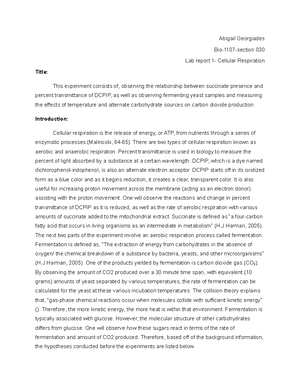

A Study of Some Digestive Enzymes: Starch/ Amylase Amylase is an enzyme found in saliva that breaks down starch into maltose and glucose. Because starch is a long branching chain it needs time to be broken down to break down into glucose and maltose. The objective of this lab was to recognize the effects of amylase on starch over a certain period of time. Over an extended period of time, if you add amylase to starch then the amylase will break down the starch gradually leaving less starch than before.
Materials & Methods Procedure and materials were based on the lab manual procedure in the, “ Biology 1107 Laboratory Manual”
Results Based on the Result from Table 15-1, the longer theamylase was present in the sample of starch the lighter the color became. The starch and amylase inthe first minute was brown because the amylase wasn't given enough time to break down the long units of starch. As time increased the sample became lighter in color (orange/yellow) as the amylase breaks the starch down even more.
Discussion Based on the results of the experiment, the hypothesis was supported as the data shown in the table showed that as amylase was present in the starch sample it was evident that there was less starch in the sample as the time increased. This experiment can be used to show how amylase in saliva starts the digestive process. The amylase hydrolyzes starches in the saliva into maltose (Russel, 1103). Thereforeby chewing more the starches in food are broken down even further because it allows the amylase to constantly break down the starches in it.
A Study of Some Digestive Enzymes: Protein Breakdown by Pepsin
Pepsin is an enzyme in the stomach that is responsible for breaking down proteins. While pepsin is the main enzyme in digestion, things like hydrochloric acid and sodium bicarbonate affect the way proteins are broken down in the stomach. In this experiment,if protein is found in the sample then the sample will turn pink.
Materials & Methods Procedure and materials were based on the lab manual procedure in the, “ Biology 1107 Laboratory Manual”
Results Based on the results of the experiment, Pepsin , HCl , and𝑁𝑎𝐻𝐶𝑂 3 all have different effects when breaking
down food into proteins especially when combined together as shown in. In tube 3 as shown in table 15-2, only HCl was present and it created a protein. In tube 4 as shown in table 15-2, only Pepsin was present and it produced a protein. However, when combined together they produced a peptide (shown in tube 5) which was pink compared to their original colors ofpurple as shown in table 15-3. In tube 6, NaHCO alone produces a protein. With no protein present the sample was blue as shown in tube one (table 15-3).
Discussion Based on the experiment, the hypothesis was supported as hydrochloric acid and sodium bicarbonate turned the sample into different forms of proteins when put together. The hypothesis is supported by a research paper, “The fate of most dietary proteins is degradation into small peptides and amino acids that are subsequently absorbed and predominantly used for new protein synthesis and energy. This process is facilitated by the proteolytic enzyme pepsin, whichis secreted by gastric chief cells as the precursor protein pepsinogen. Coupled with the secretion of hydrochloric acid (HCl) by the parietal cells of the stomach lining, pepsinogen is autocatalytically activated to form pepsin, which is a broad-spectrum protease that preferentially hydrolyzes peptide bonds between the aromatic amino acids Phe, Trp and Tyr.”(Wang) The meaning of this is that different enzymes have different effects on the digestion of proteins when they are paired with enzymes like HCLand sodium bicarbonate. They both break down the proteins into smaller peptides that allow for easier digestion and energy.
Department of Molecular and Cell Biology. “Principles of Biology, Biology 1107 Laboratory Manual." 2019. University of Connecticut. Laboratory manual.
Russell, Peter J., et al. Biology: the Dynamic Science. Brooks/Cole, 2011.
Wang, Rong, et al. “Analyzing Pepsin Degradation Assay Conditions Used for Allergenicity Assessments to Ensure That Pepsin Susceptible and Pepsin Resistant Dietary Proteins Are Distinguishable.” PLOS ONE , Public Library of Science, journals.plos/plosone/article.
Table 15-
test Negative control (𝑑𝐻 2 𝑂)
Positive Control (starch)
Starch + Amylase at 1 Minutes
Starch + Amylase at 3 Minutes
Starch + Amylase at 7 Minutes 𝐼 2 𝐾𝑙 Light Yellow Dark Purple Brown Golden light yellow
Table 15-
Tube dH2O 1% Albumin 0 M HCl 1%𝑁𝑎𝐻𝐶𝑂 3 0% Pepsin
1 4 ml 0 ml 0 ml 0 ml 0 ml 2 2 ml 2ml 0 ml 0 ml 0 ml 3 1 ml 2 ml 1 ml 0 ml 0 ml 4 1 ml 2 ml 0 ml 0 ml 1 ml 5 0 ml 2 ml 1 ml 0 ml 1 ml 6 0 ml 2 ml 0 ml 1 ml 1 ml
Table 15-
Tube Color Observed Interpretation 1 Blue No protein 2 Purple Protein 3 Purple Protein 4 Purple Protein 5 Pink/ Light purple Peptides 6 Purple Protein
Table 15-
Tube dH2O Whole 5% bile 0% 0 M 0%m Initial Final